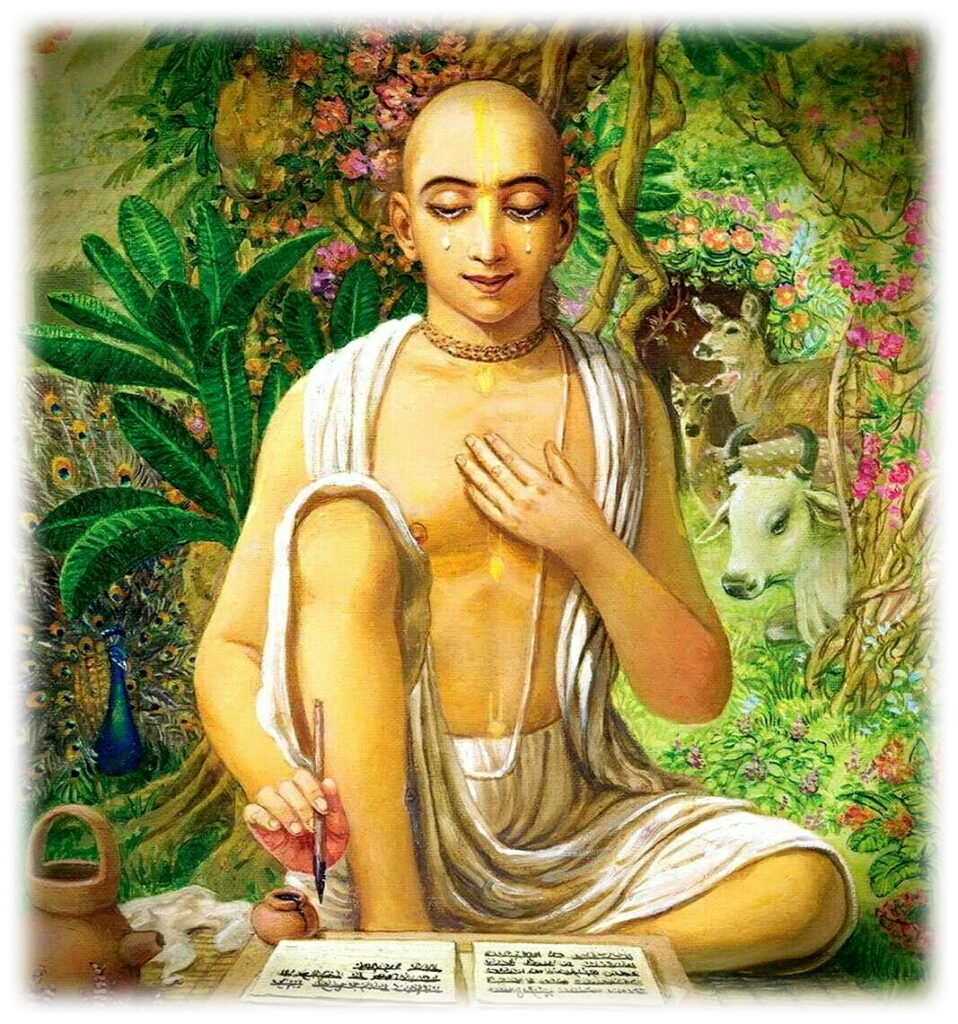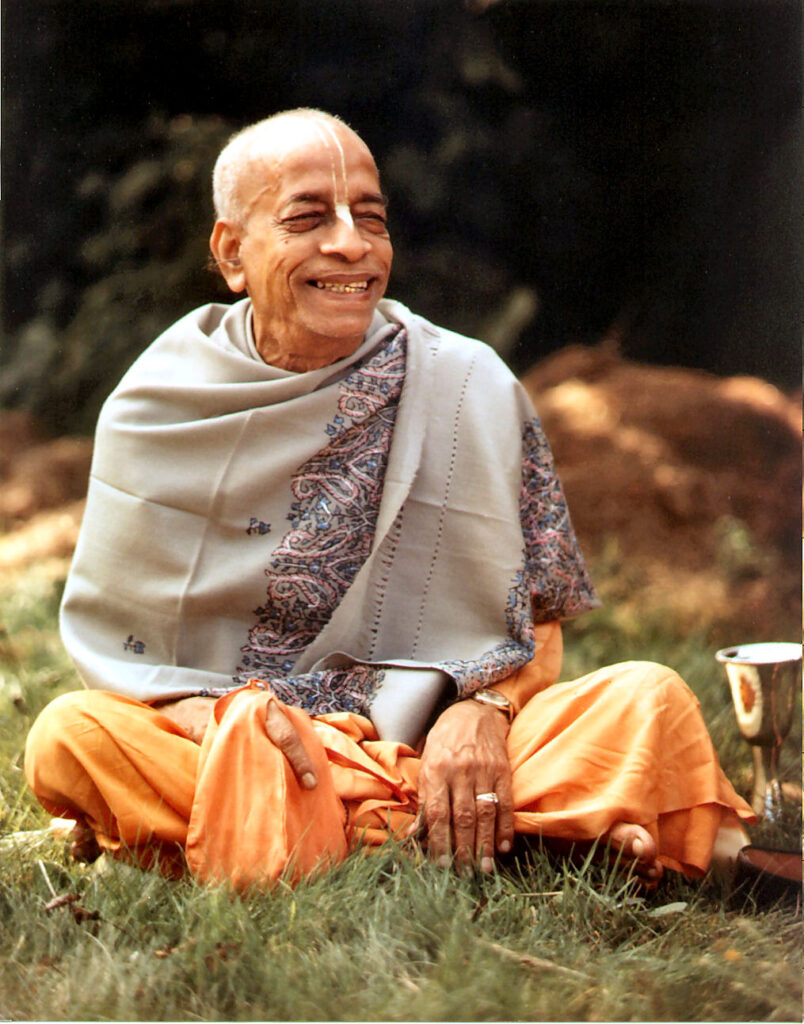What is the similarity between the Bhagavad-Gita and the Vedanta Sutra? There are actually many similarities since they describe the same Absolute Truth, which is ultimately a person, and the process of connecting with Him. The Bhagavad-Gita is one of the 108 Upanisadis, while the Vedanta Sutra describes the conclusions of the Upanisadis, and so on. These two books are actually very closely connected.
Another thing they have in common is that they describe the same five tattvas, or truths:
- Isvara (The Supreme Personality of Godhead, who is the Supreme Controller).
- Jiva (the individual souls, who are controlled by Him).
- Prakrti (the material nature).
- Kala (time, which governs the duration of the existence of the whole material manifestation).
- Karma (material activity).
These five points and the interactions between them are very important topics because when they are not properly understood, all kinds of philosophical misconceptions appear.

Srila Prabhupada explains these five points in his introduction to the Bhagavad-Gita as it is, and Srila Baladeva Vidyabhusana describes the same points in his introduction to the Govinda Basya, his commentary on the Vedanta Sutra. This is a list of points from both explanations.
From Srila Prabhupada:
a) The Lord is the controller, and there are jīvas are controlled by Him. If a living entity says that he is not controlled but completely free, he is insane.
b) The living beings are like the supreme controller in quality, but they are much less powerful, just like a particle of gold compared with the gold mine, or a drop of water compared with the whole ocean.
c) Due to that, the soul has the qualities of the Supreme Lord in minute quantity, being a minute īśvara, subordinate to the Lord. One may control a small family, trying to be supreme in his small apartment, but the Lord controls the whole cosmic manifestation. Our tendency to control exists because it is originally present in Krsna, but we must accept we are subordinate to Him.
d) Material nature is not independent. She acts under the direction of the Supreme Lord.
e) Both the material nature and the living entities are described as Prakṛti, the energy of the Lord. The material nature is the inferior prakṛti, the external energy of the Lord, while the jivas are part of the superior prakṛti or spiritual energy. However, both are under the control of the Lord.
f) Material nature has three qualities, the modes of goodness, passion, and ignorance. Above these three modes, there is eternal time, and under this combination of the three modes acting under the control of time, there are activities, which are called Karma.
g) The Lord, the living entities, material nature, and material time are eternal. Both material nature and time are manifestations of eternal potencies of the Lord.
h) The cosmic manifestation is temporary, but it is not false. The material universes are repeatedly created and destroyed, in an unlimited sequence of universal cycles.
i) The reality and temporarily of the cosmic manifestation are compared to a cloud moving on the sky. It appears, stays for some time, and then disappears. Later, another cloud comes, and so on. These cycles go on eternally. Thus, the material energy (being one of the potencies of the Lord) is eternal, but the cosmic manifestation is temporary, going eternally through cycles of creation and destruction.
j) Different from the other four items, Karma is not eternal. It’s going on for such a long time that it’s not possible to trace its beginning. However, it can be changed when one comes in contact with the mode of goodness, and it ends when the soul is freed from all material contamination.
k) Both the Lord and the jivas are conscious. The Lord is supreme conscious, and the jivas, being parts and parcels of the Supreme Lord, are also conscious.
l) Both the living entity and material nature are explained as prakṛti, the energy of the Supreme Lord, but material nature is not conscious. Amongst the two, only the jīva, is conscious.
m) Because the jiva is conscious, the jīva-prakṛti is called superior because the jīva has consciousness which is similar to the Lord’s, although minute.
n) The living being can’t be supremely conscious like the Lord at any stage of perfection. There is always an intrinsic difference between the two at every stage. The Lord and the jivas are eternally different individuals. The jiva is conscious of his own body, while the Lord, being present everywhere, is conscious of all bodies.
o) The theory that consciousness develops under certain circumstances of material combination is not accepted. Both the Lord and the jiva are eternally conscious
p) Although the consciousness of the jiva is originally transcendental, it becomes perverted when reflected in matter, just as light reflected through colored glass may appear to be a certain color. The consciousness of the Lord, however, is never materially affected. That’s why He is qualified to speak the Bhagavad-Gita and other transcendental texts.
q) At the present moment, our consciousness is materially contaminated and the goal is to purify it. When our consciousness is finally purified, our activities can be dovetailed with the will of the Lord. This will bring us ultimate happiness. Purified consciousness means acting in accordance with the instructions of the Lord. The Supreme Lord is the enjoyer and the creator, and we, as subordinate living beings, are meant to cooperate to satisfy Him.
r) THe living entity is neither the creator nor the enjoyer, but a cooperator. We don’t have to cease all activities. Rather, our activities are to be purified, and purified activities are called bhakti. Activities in bhakti appear to be like ordinary activities, but they are not contaminated.
s) The complete whole is comprised of the Lord (the supreme controller), the jivas (controlled living entities), the cosmic manifestation, eternal time, and karma, or activities. All of these taken together form the complete whole, and the complete whole is called the Supreme Absolute Truth. The complete whole and the complete Absolute Truth are the complete Personality of Godhead, Śrī Kṛṣṇa. All manifestations are due to His different energies. He is the complete whole.

From Srila Baladeva Vidyabhusana:
a) Isvara, the Lord, is supremely independent.
b) He is the master of all potencies (including the internal potency, the external potency, and the marginal potency, the jivas).
c) He enters the universe and controls it.
d) He awards both material enjoyment and ultimate liberation to the individual spirit souls (jivas) residing in material bodies.
e) Although He is one, He manifests in many forms. They who understand the transcendental science maintain that He is not different from His transcendental form and qualities.
f) Although He can’t be perceived by the material senses, He can be perceived by bhakti (devotional service).
g) He is changeless. Although unlimited manifestations come from Him, He remains as He is.
h) He reveals His own spiritual, blissful form to His devotees.
i) Some jivas are averse to the Lord and are thus bound by material illusion. Other jivas are friendly to the Lord, and thus become free from material illusion, which hides the Lord’s form and qualities.
j) Prakrti (material nature) is known by many names, such as Tamah and Maya. When the Lord glances at Prakrti, she is put into motion, generating all the different material manifestations.
k) Kala (time) is divided into many different units from the extremely brief ksana (a fraction of a second) to the extremely long parardha (155.520 trillion years). Turning like a wheel, time is
the cause of repeated creation and annihilation of the universes. Time is unconscious. It is not a person.
One could point out the apparent contradiction of considering the Lord as both the knower and the object of knowledge. Impersonalists see Brahman as an unconscious being that is the object of knowledge, and this is easy to understand since this is similar to the relationship whe have with different unconscious material objects. We are conscious and we study things, while material objects are studied by us. Similarly, impersonalists see Brahman as the object of knowledge, but not as the knower, since Brahman is impersonal. When we understand that the Lord is a person, however, this apparent contradiction appears. How can the Lord be simultaneously the knower and the object of knowledge?
Srila Baladeva Vidyabhusana, explains this point by giving the example of a lamp. The lamp is not different from the light it emanates. At the same time, we can see the lamp inside of a dark room only because of the light emanated by the lamp itself. Without this light, we would not the able to see the lamp, or anything else. Without the lamp, we can’t see anything.
Therefore, the lamp is simultaneously the object of knowledge (the object being studied), and the method for attaining such knowledge, thanks to the light it emanates. Similarly, the Lord is both the object of knowledge (the Supreme Person we wish to understand) and the process of attaining such knowledge, thanks to the Vedas and other forms of understanding that emanate from Him.
